Secrets of feeding aquarium fish

The vast majority of diseases and deaths in our domestic fish occurs due to their improper feeding. The trouble is that an aspiring amateur sometimes does not even understand the importance and responsibility for his actions in feeding matters.
The biggest and most common mistake is the feeding of fish with dry food. Hungry fish pushes on such food, swallows. Then this food in the stomach begins to rot. A very small part of it is absorbed, the rest falls into the water and changes its chemistry. The more dry food you give, the faster water spoils. Develop unnecessary organisms. Dry branded high-quality feed contains almost all the fish necessary for the fish, but you need to use them carefully.
The second error is a monotonous power. With all the diversity and accessibility of various feeds, the novice lover "pushes" his pets day by day with the same food. The choice of feed is very large, skilful combination and alternation of them will allow to grow healthy fish and concentrate their attention on more interesting aspects of life of the underwater kingdom.
Do not forget that fish are mostly predators, very few of them are feeding exclusively on vegetable feed.
Live food is needed for fish during spawning. Receiving a fair portion of bloodworm, tubule, fish go to spawn more willingly. Malek, who grew up on live food, is life-sustaining and less susceptible to diseases in the future.
A lot is written about the harm of the pipe man. In fact, this harm is greatly exaggerated. The tube can contain anything, but there are simple ways to clean it. To clean the pipe, it is enough to wash it for a week, two to three times a day. When it acquires a pink color, you can give it to fish without any fear. Some amateurs "soak" the pipe man in milk, which must also be changed.
It is worth to stay on the storage of live food. The tube is stored on the bottom shelf of the refrigerator in a wide and low vessel with a small amount of water, daily replaced. Joker can be kept between two wet wipes. As dishes, you can use photocells.
Both bloodworms and tubulars should preferably be fed through special feeding troughs. Slow feed remains in the trough, and live leaves through small holes in the aquarium. Good quality pipe with tapping instantly "folds" into a tangle. At purchase it is necessary to pay attention and on its appearance. Keep long live food is not recommended.
Without special problems you can grow daphnia yourself. In addition to feeding problems, daphnia is also of interest for observations. Especially for fry, it is desirable to have a few cans with Kolovratks. For very small fry, lovers "keep on hand" infusorians.
As an additional food for fry, use curdled milk.
Some lovers cultivate at home enchitreus. It's quite easy to keep it. To enrich the worm with vitamins, it is necessary to add vegetable waste to its food, etc. Feeding fish with enchytrate can cause obesity, therefore, like any other, this type of food must be alternated.
As a vegetable feed, it is good to use cereals. Before using them, the groats should be poured with boiling water and chilled and fed. With great pleasure, many carp, catfish, cichlids eat a mango.
When keeping a large amount of fish, there is a need for a well-balanced and inexpensive feed.
Any heat treatment, as a rule, reduces the value of the product, so the components used in the preparation of minced meat are mainly used in raw form.
The basis of stuffing
- Sea fish. Milk, caviar.
- Squid, octopus, shrimp, etc. Vegetative components.
- Nettle. You can prepare it yourself and use it in dry form. Dandelions, etc. Not more than 10%.
- Red sweet pepper ("Bulgarian"). Improved color of fish. Not more than 5%.
- Parsley, spinach, apple. Not more than 2%.
- Bow. Not more than 1%.
- Juice of garlic or lemon. Not more than 1%.
- Carrots, pumpkins and other vegetables. Before adding, cook for 5-8 minutes. Not more than 5%.
Other additives
- The liver of beef. A rich source of active substances. In minced meat - no more than 5%. You can feed fish and just pieces of liver no more than once a week.
- Egg. Binding element of stuffing.
- Food for dogs and cats. Must not contain feather flour. May cause inflammation of the intestines.
- Spirulina.
- Dry and frozen fish food. Gamarus, daphnia, etc. And also quality branded mixtures. Not more than 10%.
- Ground eggshell. Source of minerals. Badly absorbed.
- Vitamins. 1-2 tablets per 1 kg of stuffing. Sometimes I take vitamin D on the oil in a pharmacy and moisten them a bit with minced meat before feeding.
- Iodized salt. At the tip of the knife. It compensates for iodine deficiency.
It is undesirable to use in minced meat
- Bird.
- Meat of warm-blooded animals. In cases of feeding fish with beef, you should choose low-fat meat.
- River fish. Possible poisoning, parasites.
- Herbs and plants used in medicine. The effect of using them can lead to very sad and unpredictable consequences.
The ingredients of the stuffing are washed, mixed and crushed in any available way (meat grinder, mixer). For an aquarium with large fish, grinding of the components with a knife is quite suitable.
The finished mass is placed in a plastic bag and rolled into the 1-2 cm layer by hand. We store it in the freezer.
Before feeding, break off the required amount, and after thawing we place it in the aquarium. You can throw frozen pieces without thawing.
However, if you have bottom fish, they can lose lunch because the ice does not sink in the water, and as thawing, all the food can be eaten by other fish.
Gelatin, agar-agar are used as binding elements. In addition, you can pour minced strong broth, obtained after brewing the bones.
Example recipe
- 1 kg Putasu (in our market this is one of the cheapest sea fish).
- 200 grams of squid. Previously, they must be cleaned.
- A bag of dry firm feed.
- A tablespoon of dry nettle.
- One raw egg.
We pass the fish and squid through the meat grinder twice. Add dry food, nettle, egg. Thoroughly mix. The stuffing is ready.
Theoretically, storing minced meat at a low temperature in the freezer can be quite a long time. In fact, the activity of certain substances and their suitability for feeding fish can vary greatly. It is desirable to make a volume that is completely eaten by fish for a week.
The amount of given feed is determined experimentally. Feed should be given in small portions, observing the reaction of the fish. It is better if the fish is a bit short. The remains of the feed should not lie on the bottom. The frequency of feeding depends on the age of the fish. Malka is fed more often, adult fish will be enough once or twice a day.
The benefits of starvation for a man written a lot, all this is true for fish. The gastrointestinal tract needs rest. During fasting, the body is cleansed. Sick fish quickly goes on to recover, and newly acquired is better acclimatized. Once a week it is useful to arrange a complete hunger strike. The exception is the male, the food that is needed all the time.
Adult fish can starve for a week without any visible damage.
FOOD FOR AQUARIUM FISH

In natural water bodies, the food of fish is very diverse. So, living in the aquarium gorchaki, plytipecilia, molliesia, gourami in nature eat mainly vegetable food, haplochilus pick up falling on the water of insects, and cichlids (scalars and others) are predators. In the aquarium, all species receive the same common aquarium feed, the set of which is very limited.
Most aquarium species have lived in a room for many generations and perfectly adapted to aquarium nutrition. If fish are taken from a river or pond, the usual aquarium feeds are not always sufficient for them. For example, according to the description of the famous Russian aquarist NF Zolotnitsky, gorchaks begin to degenerate in the second generation: the color turns pale, the fish become sluggish, weak, and reproduce poorly. In this and similar cases it is necessary to find the feed necessary for the fish.
Gorchakov, for example, should be given filamentous algae. There are natural and artificial feeds. In all cases, where possible, it is necessary to feed the fish with natural food, which feeds fish and in natural conditions. But of course, we can not give African fodder for African fish. Just picking the right ones.
The most common natural food is the bloodworm. The bloodworm is a larva of non-biting mosquitoes of dermons, or zvontsov, which has the appearance of a bright red, divided into segments of a worm, 0.5 to 2 centimeters in length. They catch these larvae on the bottom of ponds, lakes and slowly flowing rivers. By tying a rope to the bucket, throw it into the pond. When the bucket sinks to the bottom, pull the scooped silt to the shore and, washing it in the sieve, select the remaining moth on the bottom.
This business is not easy and, in addition, very dirty. Therefore, when the bloodworm can be bought (it is sold in zoological stores in most major cities), it is not worth catching it, especially in winter: for this purpose it is necessary to cut ice, and the water is ice cold.
Motyl is a perfect food for all aquarium fish larger than 1.5 centimeters. It should be given on the basis of one to five worms per fish once or twice a day. Do not throw into the aquarium at once a lot of bloodworm. If the fish do not have time to eat it, the bloodworm buries into the sand, where it often dies and, rotting, spoils the water.
Bloodworm
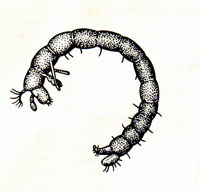
Motyl is a perfect food for all aquarium fish larger than 1.5 centimeters. It should be given on the basis of one to five worms per fish once or twice a day. Do not throw into the aquarium at once a lot of bloodworm. If the fish do not have time to eat it, the bloodworm buries into the sand, where it often dies and, rotting, spoils the water. In the aquarium, often even in the winter, one can observe the appearance of tiny creatures with distinctly visible horns and lowered arched tails floating near well-lit glass. It's a bloodworm, but now it's not a larva, but a pupa. If after a few days you see a mosquito, do not be surprised. It is from the pupa that the adult form has hatched. You can also feed the fish with moth and fish fishes as large as 6-7 millimeters. For them, larvae have to be cut into small pieces.
A bundle of butterflies (20-30 pieces) is laid on the glass and cut by sharp movements of sharp scissors, turning into a mushy mass. Tilting the glass, give a drain of blood, after which the gruel is thrown into the aquarium. Feeding fish with a cut joker must be especially careful. If there are still a few unbroken pieces left in the aquarium, rotting starts immediately and the water becomes turbid.
You can store the bloodworm in a clean damp cloth, laying it in a thin layer and placing it in a cool place (preferably with a temperature of 2-5 degrees). Sometimes the bloodworm is mixed with the tea. In this case, he lives longer, but it is difficult to choose when feeding. In summer, it is convenient to store the larvae in a dish placed on a bright light with water and an aquarium plant.
There is another very good way to store bloodworms. If the larvae are spread out in a thin layer in a flat vessel with a tightly closing lid and sprinkled a little with water, the so-called wet chamber will be obtained. The air there is saturated with water vapor, and there is a lot of oxygen. The larvae live in such a chamber, installed in a cool place, for a long time. There are other ways of storage. Bloodworm can be procured for future use by drying live larvae. Most fish eat a good dryworm, but when feeding they easily get muddy with water, and fish do not grow fast enough. It is better than dry drill frozen. You can not feed the fish dead, spoiled by bloodworm.
DRAIN PIPE
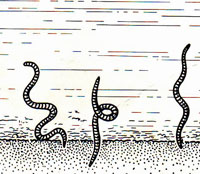
In very heavily polluted water bodies, the silt surface is often, like a carpet, covered with a lot of thin red worms, half buried in silt. These worms sometimes multiply very much in the aquarium, if it is poorly lit and kept untidy. It's a tube, or tubifix. This worm is a good food for fish. They store it the same way as the bloodworm, or in a bowl with water, which is changed twice a day. This method is the best, tubers can live in such conditions for months. Before feeding, the worm is cut, otherwise it will immediately burrow into the sand. If it is difficult to wash the tubifikos from the silt of a natural reservoir with a sieve (when the silt is heavily soiled), they are placed together with the mud in a bucket and heated from the bottom. Escaping from the heat, tubers creep to the surface, where they are easy to choose.
Live food - Daphnia and Cyclops
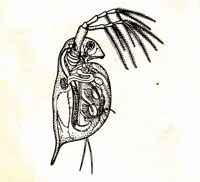

In standing and slowly flowing water there is a wonderful food for fry and small adult fish: various floating crustaceans and mainly cyclops and daphnia. They are small, translucent and move in the water with the help of rowing movements of their oar-antennae. Their size is often less than a millimeter, and they are indispensable for feeding juveniles. The dirtier the pond, the better, as a rule, live food in it - the crustaceans here have adapted to the transfer of all kinds of adversities.
Catching crustaceans, passing water through a long net on a long stick. Sack bag is best made of silk or nylon and perlon. Often, the net is made in combination: the bottom is sewn from a dense fabric (for example, cotton), the upper one is attached to the hoop, from a fabric that is good for water (for example, an old nylon stocking). Sacks of gauze are suitable only for catching large daphnia; Cyclops and daphnia juveniles pass through them.
It is better to make a stick with a length of up to three meters, composite or foldable. Often, thin thin tubes are used for this, and joints are made on the thread. To carry live food from the pond home is most convenient in a special vessel - canna. You can also use a bucket, a can, a jar for this purpose. Water in the vessel must be poured in such a way that its depth is less than the width of the vessel. And sometimes they wear the food in a different way - on fabric sieves stretched over a frame.
Rachkov put a layer of about 0.5 centimeters, and the frame is placed in a vessel on the bottom of which is poured a little water. Some of the crustaceans die in this way, but in a "dry" form they can be brought very much. The brought cyclops are placed in a basin, from time to time changing the water in it. To do this, the upper layers of water are filtered through a net, and the crustaceans that settle at the bottom are discarded. Too many cyclops should not be kept - they perish during re-consolidation and become unsuitable for feeding fish. In the aquarium you need to start up as many cyclops and daphnia as the fish eat for 1 to 2 hours. Is it necessary to catch the cyclops yourself? Is it not easier to buy them at a zoological store? Of course, it's easier. But for many aquarists, getting food is an interesting activity. In addition, it hardens a person physically.
Daphnia can be specially bred somewhere in a barrel. In soft water throw slightly dry cow dung and crustaceans. You need to feed them with yeast, and in such a way that the water all the time was slightly (not much!) Unclear. Daphni prepare for future use, drying. The best are the large crustaceans dried in the sun in early summer. If you feed the fish with one dry food, they grow poorly and multiply. With the addition of vitamin D to dried daphnias, the growth and fertility of fish is improved. A match box of dry daphnia is added one or two drops of an oil solution of vitamin D or fish oil. Grinded powder dry daphnia allowed in a special, floating on the surface of the aquarium feeder from the sealed glass tubules. Like moths, cyclops and daphnia can be harvested for the winter, freezing.
Dry food Crustacean-bokoplav (gammarus)
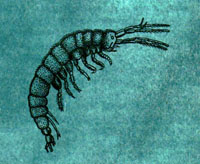
Crustacean-amphipod (gammarus). Live amphipods are a delicious food for many commercial fish. Not without reason, even a winter fishing hook (mormyshka) in shape resembles a beetle, which is sometimes called a marmic. In dried form, the crustacean is rather hard. No aquarium fish can eat it whole. But if the crustaceans grind into the dust, the fish eat them very readily. On nutrition, this feed is better than dry daphnia, but, of course, inferior to live food. This food is suitable for many fish. It is good to feed the fish with dry food, mixed with the cut joker.
Live food - Coretra
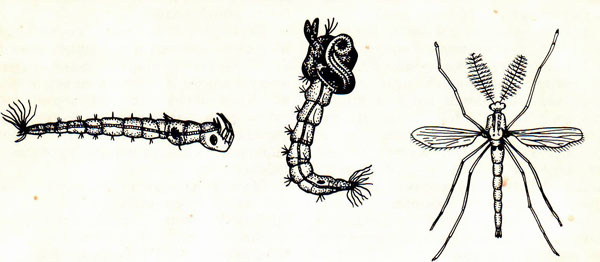
In the same place where Cyclops and daphnia are caught, a long transparent corpus will often enter the net. This is the gnat's face. The size of the coronet is about a centimeter. Not yielding to nutritional motyl, the correlator has in comparison with it some advantages: it does not burrow into the sand and is very insensitive to the amount of oxygen dissolved in the water. In this glass, you can put several hundred corets. These larvae are very resistant to unfavorable conditions. One day, when my canna was full of Cyclops, I found myself in a puddle, in which many corets floated. I had nowhere to plant them, and, having caught thousands, I put them just in the newspaper and put them in my pocket. Only two hours later they got into the water, and not one larva perished. I think that this is how it is, without water, that the coretre should be carried home from the pond. Or maybe they can be stored in a wet cell? Try to put such an experience. Contain coretra should be at low temperatures; In heat, it quickly pupates and becomes unsuitable for feeding. Fish, accustomed to the bloodworm, catch the korretra reluctantly, however, after being hungry, they begin to greedily eat it.
Live dust
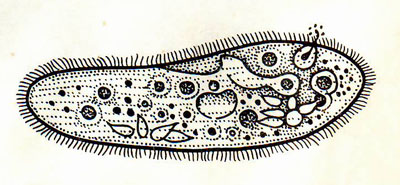
In the warm season, along with cyclops, a dense net can often catch a huge number of tiny creatures: infusorians, rotifers, cyclopean and daphnia larvae. When viewed with a simple eye, they appear to be hardly noticeable moving points. All that can be separated by filtering through a marquette or kapron net, aquarists call "living dust". This is the best feed for newly hatched fish eggs from the larvae. To feed "live dust" you need two or three times a day, giving as much as can be eaten in 1 to 2 hours. Perfectly replace the "living dust" specially bred infusoria. The best for this purpose is a shoe.
It is not difficult to breed it. Take rotten parts of aquarium plants and squeeze them into a test tube. When the cloud settles, looking at the light, they catch a pair of shoes, which are easy to recognize by their characteristic form. The infusorians are placed in a can (2-3 liters) with cooled boiled water, pouring in two or three drops of milk or diluted in water yeast. The water temperature should be 20-25 degrees. After enlightening the water, the infusorians are again fed with milk or yeast. After 10-15 days, the bank usually has a lot of shoes.
Infusoria well divorced, if a can of a banana peel, fresh or dry - it does not matter. In this case, it is not necessary to feed milk or yeast. A piece of banana peel can be podkladyvat every 10-15 days. To feed the larvae take a day 1 - 2 cups of water with infusoria. In the jar immediately need to pour a cold boiled or just raw tap water and feed infusoria. The more often you replace water, the better the shoes will multiply. One three-liter jar with shoes is usually enough for the feeding of a hundred fish larvae.
An interesting method of breeding infusorians is used by aquarists of the German Democratic Republic. At the bottom of a liter glass vessel, they lay a thin layer of silt taken from the bottom of some small pond or a long-drying puddle (marsh mud is not good). Water is poured into the vessel by the marsh. As a feed for infusorians put a small cube of turnip or rutabaga, and on top of the vessel tightly covered with glass. With this method, only shoes are reproduced in the vessel. Oxygen in the vessel is small, so millions of infusorians gather in the upper layer, forming a whitish "milk of milk" on the surface. From there they can be easily pipetted.
How to make, that in an aquarium together with infusoria got less dirty water? There are many ways, but here is one of them - simple and good. In a long, narrow tube, pour water with infusoria and place it vertically. Two hours later, the infusorians will gather on the surface, where there is more oxygen. It remains only to select the "infusion cork" with a pipette and feed it to the fish. You can speed up the movement of the shoes by darkening the lower part of the tube. You can put a cotton swab into the upper end of the tube, and pour a little fresh water over it. Infuzorii through vatu prolezut. Apply and other methods. Filter the infusion water through blotting paper or, if the water is drained from the surface of the jar with infusoria (but without the banana), stand it for 4-6 days.


Comments
When commenting on, remember that the content and tone of your message can hurt the feelings of real people, show respect and tolerance to your interlocutors even if you do not share their opinion, your behavior in the conditions of freedom of expression and anonymity provided by the Internet, changes Not only virtual, but also the real world. All comments are hidden from the index, spam is controlled.